St. George’s Memorial Church, Ieper (Ypres)
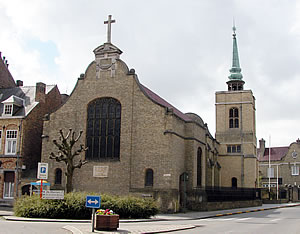
|
St. George's Church was built as a memorial to British and Commonwealth troops who lost their lives in the Great War. It is a “living” church, serving the needs of a local congregation and many thousands of pilgrims who have been visiting the battlefields of Flanders since war ended in 1918.
The Idea for a British Church in Ypres
Immediately after the Great War there was discussion about the idea of having an Anglican church in Ieper. The intention was to build it not only as a memorial but also as somewhere for the relatives of the fallen to visit and find a peaceful place for reflection. However, there were opposing views to having a church of one particular faith.
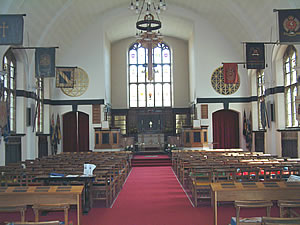
|
In 1924 Field Marshal Sir John French, President of the Ypres League, made a request for donations to be put towards the construction of a church in Ypres, as it was still called in those days. There were various suggestions for the location of a church or chapel, including near to the old Menin Gate at the eastern exit of the town, near to the Lille Gate (Rijselpoort) at the southern exit of the town or on the ramparts. None of these were considered suitable for various reasons at the time.
Eventually there was agreement that a piece of land on the north-western corner of the Vandenpeerboomplein, not far from St. Martin's cathedral, could be purchased. The architect Sir Reginald Blomfield was given the task of designing the church. He was already involved with the architectural design of a number of the British and Commonwealth military cemeteries in the Ypres Salient.
The Idea for a British School
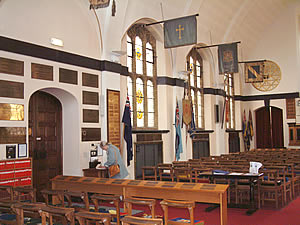
|
In addition to the church, it was decided to open a school. It was to be funded from donations by Old Etonians. There were over 300 students from Eton who had lost their lives in the Ypres Salient in 1914-1918.
Building the Church and School
The foundation stone of St. George's Memorial Church was laid by Field Marshal Lord Plumer in 1927. The exterior design for the building was a simple, elegant brick building in keeping with the buildings being reconstructed in their original pre-war style all around it.

|
Inside the church the decoration was simple too, with room for about 200 people to gather at the same time. The intention was that the interior would serve as a memorial to individuals. Families, schools and military units donated items of furniture, plaques, windows, the font and the altar.
On 24 March 1929 the Bishop of Fulham dedicated the completed church and opened it for worship.
Initially the school was made up of a staff room and one classroom only. The school opened a couple of weeks later on 9th April 1929. There were 62 pupils starting at the school at that time, most of whom were the children of workers with the Imperial War Graves Commission. Their homes were generally scattered around the old Ypres Salient.
The School: 1929 - 1940
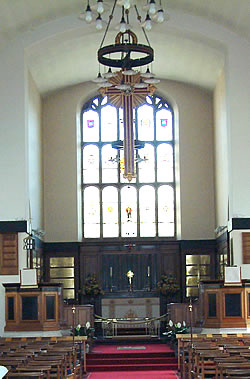
|
The teachers and headmaster came to the school from the United Kingdom. The school increased in numbers over the years to 130 pupils in 1933. As the number of pupils grew, the school took over another large room called the Pilgrim's Hall, which had been built as part of the complex as a social centre for visiting pilgrims and the local British community.
A school bus provided by the Imperial War Graves Commission brought the children, boys and girls, to school from their homes in the villages all around the town of Ypres. A school uniform was introduced, along with events typical in British schools such as playing cricket and nativity plays at Christmas. Frequently there were visits by important people including King Leopold III, the Belgian King, who had himself studied at Eton college in 1914-1918.
In May 1940 the school was closed when the 100 children attending the school from British families returned to the United Kingdom after the outbreak of the Second World War.
The Second World War Years
Before the Second World War broke out in September 1939, St. George's Church had been a busy focal point of the local community. There was a church choir, a Sunday school and regular services. BBC radio had broadcast services from the church to listeners all over the world.
When the Second World War came to Ypres, in the form of the German Army's occupation of the town, the local people took away many of the items from the church to hide them for safe-keeping. This was also done by local people for the treasures in Toc H (Talbot House), Poperinghe, during the German occupation.
During the war it was Belgian children who were educated in the school at St. George's church. The Germans used the Chaplaincy as their officers' club. For this reason the building was well-treated, as was the inside of the church and none of the fixed memorials that could not be removed were damaged.
St. George's Memorial Church Today
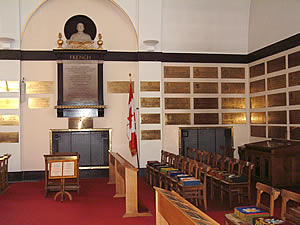
|
After the Second World War the church received funds for its running costs from the British Legion. The Chaplain was paid for partly by the Imperial War Graves Commission. The British community had dwindled in size by the end of the war so there was a much smaller number of people to attend the church on a regular basis, and there were hardly any British children who would attend the school if it was to re-open. The chaplaincy and the Pilgrim's Hall were sold.
Since 1962 the Chaplaincy of St. George's has been linked with that of St. John's in Ghent, a town north of Ieper in Belgium. St. George's Memorial Church is within the jurisdiction of the Church of England's Diocese in Europe.
In recent years there has been a renewed interest in the Great War by families tracing a relative who fought in the First World War. Many visitors to Ieper now call in to St. George's church, either to look at the special memorials or to spend a few moments of quiet reflection. Regular services are held at the church by the Chaplain and there is a choir and volunteer committee members, who dedicate their time to help with the running of this special place.
Services are ecumenical and all are welcome to attend.
11 November Armistice Day Morning Service
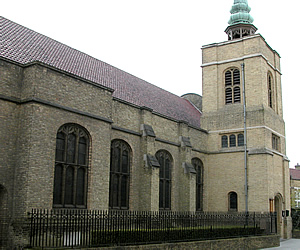
|
One of the special annual services is the morning service on 11 November to commemorate Armistice Day. In recent years the number of visitors to Ieper for the Armistice commemorations has grown in size dramatically. Places at the St. George's 11 November morning service are allocated by ticket, which can be applied for in advance from the Secretary of St. George's Church.
Visit the St. George's Memorial Church website for details:
Website: www.stgeorgesmemorialchurchypres.com
See also our page about the annual commemorative events on Armistice Day:
Opening Hours
The church is open to visit daily from 10.00 to 18.00 hours.
Location of St. George's Memorial Church
St. George's Church is a few minutes' walk from the Cloth Hall and the centre of Ieper. The church is located at no. 1 Elverdingsestraat and at the north-west corner of Vandenpeerboomplein.
Information on St. George's Church Events and Services
For information and details of services and events visit the St. George's website at:
Website: www.stgeorgesmemorialchurchypres.com
Related Reading

The Children Who Fought Hitler: A British Outpost in Europe
by James Fox and Sue Elliott
This is the story of the children who attended the British Memorial School at St. George's and how they played a heroic part in the Second World War when Ypres was occupied by the German Army. James Fox was himself a pupil at the school in 1940.
Acknowledgements
Greater Love Hath No Man: St George's Memorial Church Ypres by Gillian Hawkes, B.A., M.A., Ph.D.



